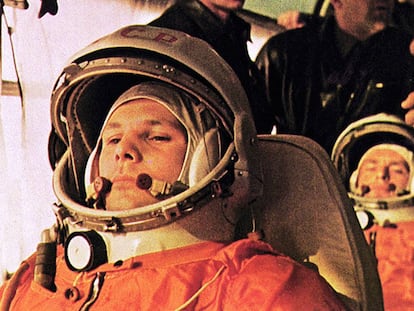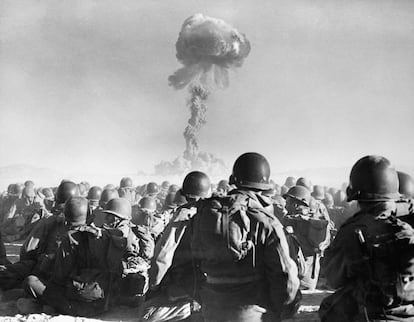
Could the United States have dropped the first atomic bomb on Nazi Germany?
An exhibition in Berlin debates what would have happened if German history had taken alternative paths and the allies had not unexpectedly captured the Remagen bridge intact, potentially extending World War II by months
Germany, and not Japan, could very well have been the first country to suffer a nuclear attack in the final stretch of World War II. In 1945, the United States considered using the atomic bomb on a German city to hasten the surrender of the Third Reich, as recalled and explored in a very interesting alternative history exhibition at the German Historical Museum (DHM) in Berlin. The political and moral consequences of that decision would have profoundly changed the history of Germany and the world — would West Germany have aligned itself with the Atlantic Alliance, would German guilt for the Holocaust have carried the same weight? The failure of Adolf Hitler’s last-ditch counteroffensive in the Ardennes (December 16, 1944 to January 25, 1945) and the fortuitous capture on March 7, 1945 of the Remagen Bridge intact — “the miracle of Remagen” — which offered the Allies an unexpected passage over the Rhine, the crossing of which was expected to be extremely difficult, were decisive, the exhibition points out, in Washington not resorting to the atomic bomb, as these events shortened the war in Europe.
The possibility that Germany could have been the target of a bomb like Little Boy, which was dropped on Hiroshima on August 6, 1945, is one of the topics addressed by the DHM in its exhibition Roads not Taken. The exhibition, which can be visited until January 11, 2026, proposes an unusual exercise in “what if,” or alternative or counterfactual history, focusing on 14 key moments in 19th- and 20th-century German history that could have turned out differently. The exhibition includes photographs, videos, posters, paintings, and objects as varied as a Reichstag election ballot on which Hitler is the only candidate, a Pickelhaube (a Prussian spiked helmet), an 1862 Dreyse rifle, and a 1955 American game of skill that requires the placing of toy bombs on Hiroshima and Nagasaki.
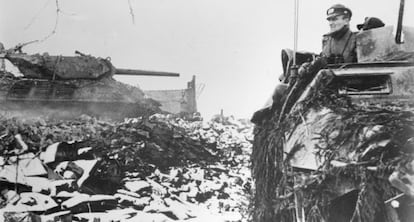
One of the speculations included is what would have happened had Hitler died in the July 20, 1944 bombing carried out by Claus von Stauffenberg in the Wolf’s Lair, in Operation Valkyrie. The exhibition emphasizes that even if the death of the Nazi leader had led to an armistice, it would have come too late for the victims of the Holocaust, since the extermination of Jews in the Nazi sphere of dominance had almost been completed. On the other hand, many German lives would have been saved: 34% of German army casualties in World War II occurred between the summer of 1944 and the end of the war in 1945 — 348,960 in the month of August alone. Other crucial moments in German history that are imagined with different evolutions are the protests and demonstrations in October 1989 in the German Democratic Republic (GDR) that led to the fall of the Berlin Wall — what would have happened if they had been brutally repressed like those in Beijing that same year — or Billy Brandt’s genuflection in Warsaw before the monument to the ghetto martyrs: what would have happened if the chancellor had lost the 1972 motion of censure?
Also included in the exhibition is a section on the assumption that the construction of the Berlin Wall in 1961 would trigger a third world war, another on a possible German reunification under communist auspices, and one imagining that the blockade of Berlin would lead to an open confrontation. The assumption that France prevented the remilitarization of the Rhineland in 1936, that a military dictatorship might have been installed in Germany instead of the Nazi dictatorship, or that the monarchy would have been maintained instead of giving way to the Weimar Republic, are also analyzed.
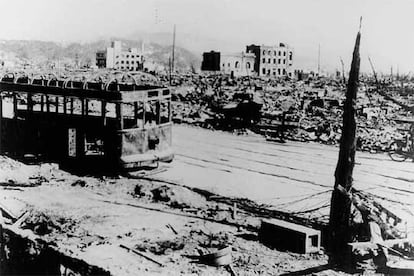
With regard to the atomic bomb, the exhibition invites us to imagine that the U.S. dropped one on Germany in 1945, “which did not happen, of course, but it is not as far-fetched as it might seem,” the museum stresses. In fact, the exhibition includes an excerpt from the memoirs of General Leslie R. Groves, director of the Manhattan Project, the program to manufacture the bomb, in which the he says: “Roosevelt informed me if the European war was not over before we had our first bombs he wanted us to be ready to drop them on Germany.” Groves details that it was “December 30 or 31″ 1944, and Roosevelt “was quite disturbed over the Battle of the Bulge and he asked me at that time whether I could bomb Germany as well as Japan.” The exhibit recalls that a million soldiers fought in Hitler’s last feint in the West, which inflicted more casualties on U.S. forces than any other land battle in World War II and concludes that, had the Ardennes campaign succeeded, “it might have prompted the deployment of the bomb.”
Another episode that would have been decisive in whether the bomb was dropped, the exhibit notes, is that of the Ludendorff Bridge at Remagen, had the explosive charges set by German forces detonated successfully. As a sign reads: “The end of the war in Europe is extended by months [by the demolition of the bridge.] To force the Germans to capitulate, President Harry Truman [who had succeeded Roosevelt] decides to drop the first atomic bomb on Germany.”
Invited by the organizers of the exhibition to provide his opinion, Karl-Heinz Frieses, head of the Department of World Wars at the German Research Office for Military History, says: “The answer to this question does not require much imagination, and it makes historians shudder. The first atomic bomb would not have fallen on Hiroshima, but on a German city.”
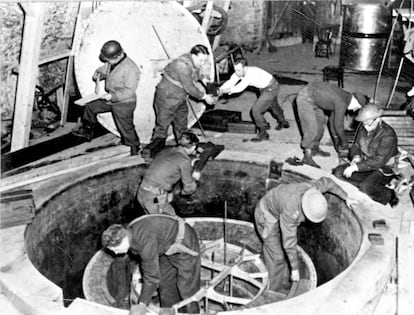
The exhibition even suggests which city that would have been: Ludwigshafen in the present-day Rhineland-Palatinate which, together with Mannheim and Heidelberg, is one of the most important cities in the Rhine Neckar Area. Born in the city and, at that time, aged 15, serving in an anti-aircraft unit as a member of the Hitler Youth, was future German Chancellor Helmut Kohl (1930-2017), who oversaw the country’s reunification and the end of the Cold War.
Not all historians agree that the U.S. would have dropped the bomb on Germany. Consulted by this newspaper, Antony Beevor points out that he does not do alternative history but, in any case, the Americans would not have deployed an atomic bomb when the Red Army was closing in on Berlin. “The prevailing wind in northern Europe is from the west, so the consequences of the explosion would have fallen directly on the Soviet lines. It is easy to imagine how a paranoid Stalin would have reacted!”
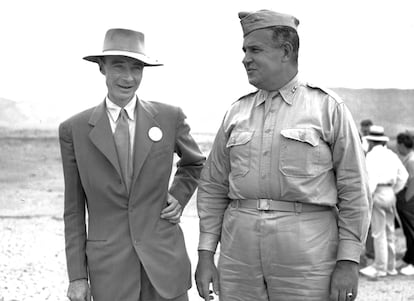
Paradoxically, the exhibition recalls, the U.S. had initiated its development of the nuclear weapon to prevent the Germans from beating them to it, aware that Germany was a pioneer in nuclear fission research. In fact, the Allies always feared that the Nazis had an atomic ace up their sleeve: they even considered the possibility of the Germans deploying a sort of radioactive barrier on the beaches of Normandy to prevent the D-Day landings. How close the Nazis came to developing an atomic bomb is still a matter of speculation. Among the objects on display is a uranium cube, a relic of the Nazi nuclear research program and one of 664 recovered after the testing of an experimental nuclear reactor at Haigerloch toward the end of the war.
The exhibition points out that the initially favorable course of the war for Hitler slowed down nuclear research. When the contest became one of survival, there were no longer enough resources for a Nazi nuclear program — not forgetting, of course, the feat of the heroes of Telemark in sabotaging the heavy water plant in Vemork, Norway. Hitler’s lack of imagination and scientific culture, and his contempt for what he viewed as Jewish lucubration (in addition to the purge of scientific talent caused by Nazi anti-Semitism), probably also played a role.
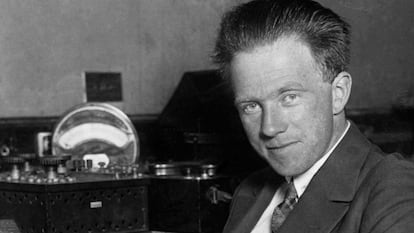
It has also been pointed out that the most celebrated figure in the German program, the ambiguous and enigmatic Nobel laureate Werner Heisenberg, was not, unlike Robert Oppenheimer on the other side, much more focused on the task, that he did possess the right personality. What does seem unquestionable is that if Hitler had had the bomb, he would have used it without hesitation. The fact that he did not was because German scientists were unable to produce one, not because they had any moral prejudices or principles as some tried to suggest after the war (see the enlightening and passionate Hitler’s Scientists, Science, War, and the Devil’s Pact, by John Cornwell).
Sign up for our weekly newsletter to get more English-language news coverage from EL PAÍS USA Edition
Tu suscripción se está usando en otro dispositivo
¿Quieres añadir otro usuario a tu suscripción?
Si continúas leyendo en este dispositivo, no se podrá leer en el otro.
FlechaTu suscripción se está usando en otro dispositivo y solo puedes acceder a EL PAÍS desde un dispositivo a la vez.
Si quieres compartir tu cuenta, cambia tu suscripción a la modalidad Premium, así podrás añadir otro usuario. Cada uno accederá con su propia cuenta de email, lo que os permitirá personalizar vuestra experiencia en EL PAÍS.
¿Tienes una suscripción de empresa? Accede aquí para contratar más cuentas.
En el caso de no saber quién está usando tu cuenta, te recomendamos cambiar tu contraseña aquí.
Si decides continuar compartiendo tu cuenta, este mensaje se mostrará en tu dispositivo y en el de la otra persona que está usando tu cuenta de forma indefinida, afectando a tu experiencia de lectura. Puedes consultar aquí los términos y condiciones de la suscripción digital.
More information
Archived In
Últimas noticias
Most viewed
- Sinaloa Cartel war is taking its toll on Los Chapitos
- Oona Chaplin: ‘I told James Cameron that I was living in a treehouse and starting a permaculture project with a friend’
- Reinhard Genzel, Nobel laureate in physics: ‘One-minute videos will never give you the truth’
- Why the price of coffee has skyrocketed: from Brazilian plantations to specialty coffee houses
- Silver prices are going crazy: This is what’s fueling the rally


